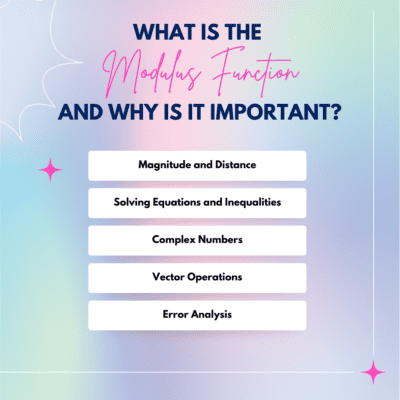The recent removal of the modulus function from the Singapore Additional Mathematics syllabus (4049) has sparked significant debate among math experts. The modulus function, also known as the absolute value function, holds substantial importance in the field of mathematics, and its exclusion from the curriculum is seen by many experts as a notable drawback.
An apparent contradiction arises when considering the Elementary Mathematics Syllabus, where students are expected to calculate the magnitude of Vectors, represented by the $\left| \overrightarrow{AB} \right|$. It raises the question of why the modulus function is removed from the Additional Mathematics Syllabus. Many experts would argue that this makes the understanding of the modulus function incomplete.
This article delves into the concept of the modulus function and its foundational importance in a student’s mathematical learning.
What is the modulus function?
The modulus function, also known as the absolute value function, is a mathematical function that returns the magnitude or distance of a real number from zero on the number line. It is denoted by the vertical bars “|” surrounding the number. For any real number “x,” the modulus function is defined as:
$\left| x \right|=\left\{ \begin{matrix}-x\text{ if }x\ge 0 \\x\text{ if }x<0 \\ \end{matrix} \right.$
In simpler terms, the modulus function essentially gives the positive value of a number, discarding its sign. For positive numbers, the result remains the same, while for negative numbers, it changes the sign to positive.
For example: $\left| -2 \right|=2$, $\left| 10 \right|=10$ and $\left| -\pi \right|=\pi $.
Importance of the Modulus Function:
- Magnitude and Distance: The modulus function allows us to measure the magnitude or distance of a number from zero. This is valuable in various fields like physics, engineering, and statistics, where the absolute value of a quantity can represent important physical quantities, distances, errors, or differences.
- Solving Equations and Inequalities: The modulus function is essential in solving equations and inequalities involving absolute values. It helps in finding the solutions by breaking the problem into cases based on whether the number inside the modulus is positive or negative.
- Complex Numbers: In the context of complex numbers, the modulus function is used to find the magnitude or absolute value of a complex number. For a complex number “$z=a+b\mathbf{i}$” (where “$a$” and “$b$” are real numbers, and “$\mathbf{i}$” is the imaginary unit), the modulus is defined as $\left| z \right|=\sqrt{{{a}^{2}}+{{b}^{2}}}$, which represents the distance of the complex number from the origin in the complex plane.
- Vector Operations: In linear algebra and vector calculus, the magnitude of a vector (which is similar to the modulus of a real number) is crucial in calculating vector operations such as normalization, finding dot products, and determining the angle between vectors.
- Error Analysis: In various scientific and engineering applications, the modulus function is used to calculate absolute errors or to ensure that values remain non-negative, as negative values may not make sense in certain contexts.
Overall, the modulus function is a fundamental mathematical concept that finds applications in a wide range of fields, helping us understand the magnitude of quantities, solve equations and inequalities, and perform vector operations, among other important uses.
Disadvantages of not learning the Modulus Function:
- Limited Problem-Solving Skills: The modulus function is a fundamental concept in mathematics that plays a crucial role in solving equations and inequalities. By not learning about it, students miss out on a valuable problem-solving tool that can be applied in various mathematical and real-world scenarios.
- Difficulty in Understanding Concepts in Advanced Math: In higher-level H2 mathematics and sciences, such as calculus, complex numbers, and vector calculus, the modulus function becomes even more essential. Without a solid understanding of absolute values, students may struggle to comprehend and work with these advanced concepts, hindering their progress in STEM-related subjects.
- Incomplete Understanding of Number Line: Understanding the modulus function helps students grasp the concept of the number line more comprehensively. It enables them to interpret the distance between numbers, understand the concept of magnitude, and work with positive and negative values.
- Limited Applications in Real-Life Scenarios: In many real-world situations, absolute values are used to represent distances, errors, or differences between quantities. By not learning the modulus function, students may struggle to interpret and solve problems involving such applications.
- Hindrance in Algebraic Manipulations: Modulus functions are often used in algebraic manipulations to simplify expressions and solve equations. A lack of familiarity with this concept may make certain algebraic problems appear more complex than they actually are.
- College Entrance Examinations: In some educational systems, the modulus function is included in standardized tests and college entrance examinations. If students haven’t learned about it, they may face difficulties in answering related questions, potentially affecting their test scores and college admission prospects.
- Limitation in Complex Number Understanding: Complex Numbers involve both real and imaginary parts and are widely used in various branches of science and engineering. Understanding the modulus function is crucial for comprehending the magnitude of complex numbers and their geometric representation on the complex plane.

Inclusion of the modulus function in secondary school examinations around the world
- General Certificate of Secondary Education (GCSE) – United Kingdom
- International General Certificate of Secondary Education (IGCSE)
- Central Board of Secondary Education (CBSE) – India
- Australian Curriculum – Australia
Conclusion
In conclusion, many math experts argue that removing the modulus function from the Singapore additional mathematics syllabus could have adverse consequences. Its absence may lead to an incomplete understanding of mathematical concepts, impede problem-solving skills, and limit students’ ability to tackle more advanced mathematical concepts and real-world applications. As such, reevaluating the curriculum to reintroduce the modulus function could be a step towards providing students





